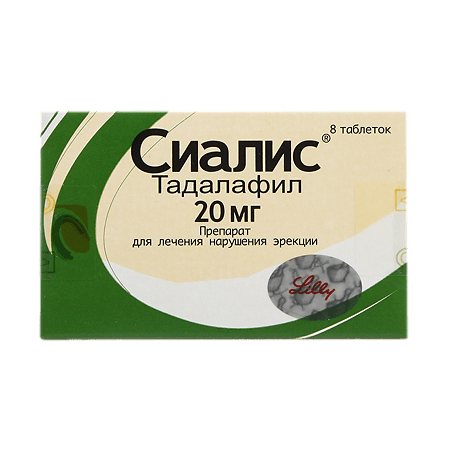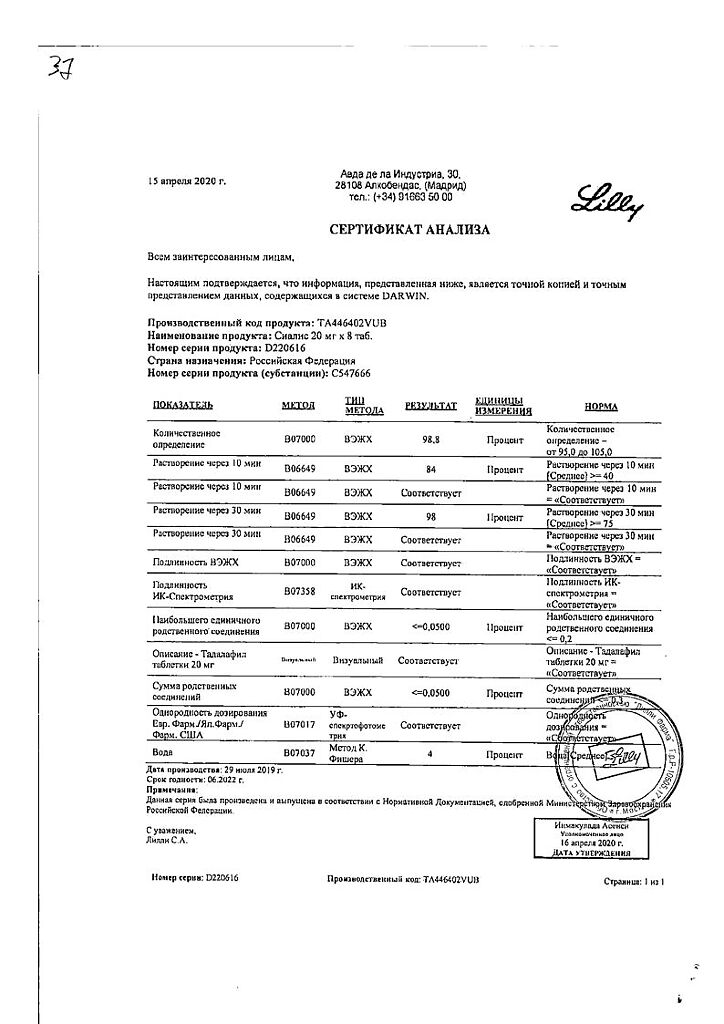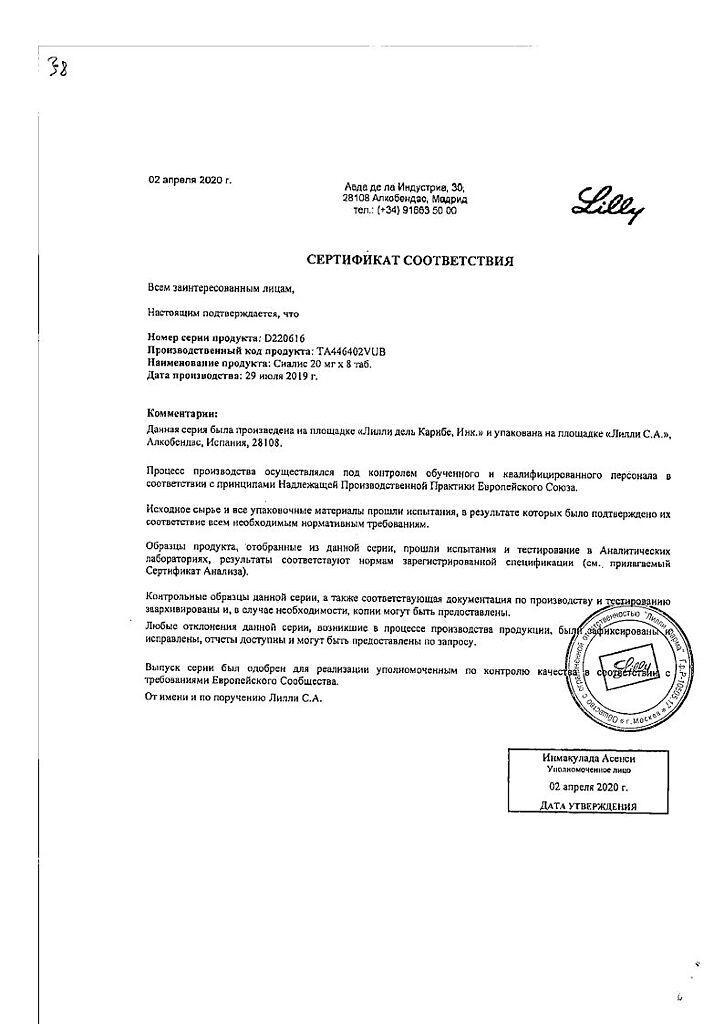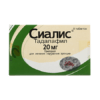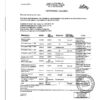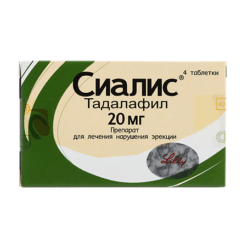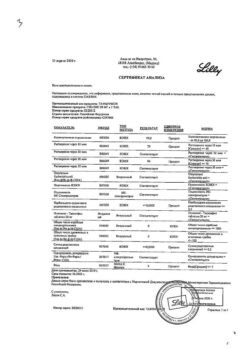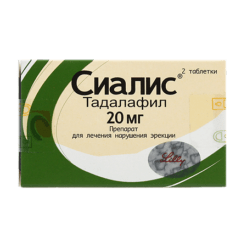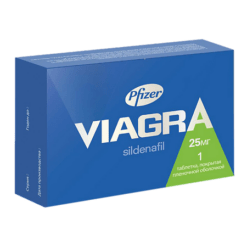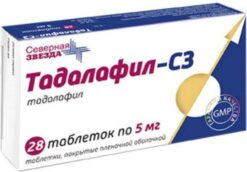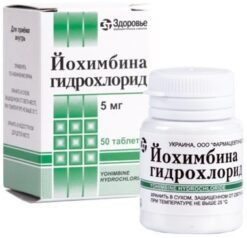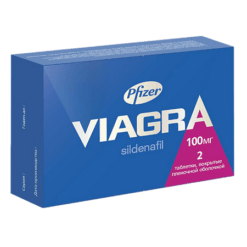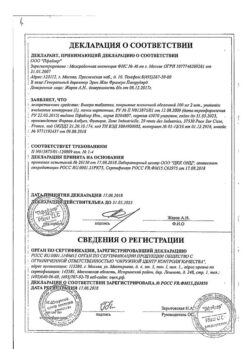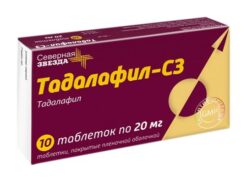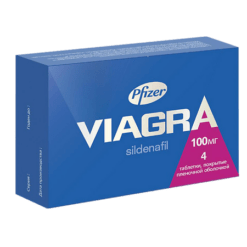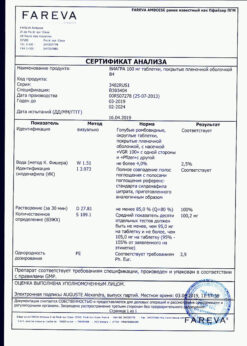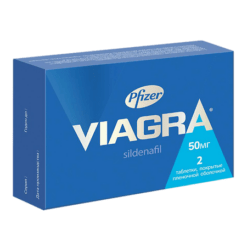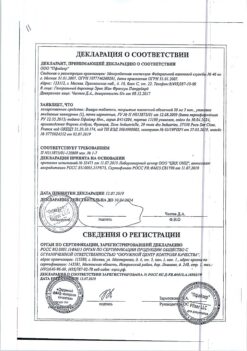No products in the cart.
Cialis, 20 mg 8 pcs
€567.53 €472.94
Out of stock
(E-mail when Stock is available)
Description
Pharmacodynamics
Tadalafil is a reversible selective inhibitor of specific phosphodiesterase type 5 (FDE-5) cyclic guanosine monophosphate (cGMP).
When sexual arousal causes local release of nitric oxide, inhibition of FDE-5 by tadalafil leads to increased concentration of cGMP in the cavernous body of the penis. The consequence of this is relaxation of the smooth muscles of the arteries and blood flow to the tissues of the penis, which causes an erection.
Tadalafil has no effect in the absence of sexual arousal.
In vitro studies have shown that tadalafil is a selective inhibitor of FDE-5. FDE-5 is an enzyme found in the smooth muscles of the cavernous body, in vascular smooth muscles of internal organs, in skeletal muscles, platelets, kidneys, lungs and cerebellum. The action of tadalafil on FDE-5 is more active than on other phosphodiesterases.
Tadalafil is 10,000 times more potent against FDE-5 than against FDE-1, FDE-2, FDE-4 and FDE-7, which are localized in the heart, brain, blood vessels, liver, white blood cells, skeletal muscles and other organs.
Tadalafil is 10,000 times more active in blocking FDE-5 than FDE-3, an enzyme found in the heart and blood vessels. This selectivity for FDE-5 over FDE-3 is important because FDE-3 is an enzyme involved in heart muscle contraction. In addition, tadalafil is about 700 times more active against FDE-5 than against FDE-6, which is found in the retina and is responsible for phototransmission.
Tadalafil is also 9,000 times more potent against FDE-5 compared to its effect on FDE-8, FDE-9 and FDE-10, and 14 times more potent against FDE-5 compared to FDE-11.
The distribution in tissues and physiological effects of FDE-8 to FDE-11 inhibition have not yet been elucidated.
Tadalafil improves erection and increases the ability to have a full sexual intercourse.
Tadalafil in healthy subjects causes no significant change in systolic and diastolic blood pressure compared to placebo in the supine position (mean maximum decrease is 1.6/0.8 mm Hg, respectively) and in the standing position (mean maximum decrease is 0.2/4.6 mm Hg, respectively).
Tadalafil causes no significant change in heart rate. Tadalafil does not cause changes in color recognition (blue/green), which is due to its low affinity for FDE-6. In addition, there is no effect of tadalafil on visual acuity, electrostinogram, intraocular pressure and pupil size.
To evaluate the effect of daily tadalafil administration on spermatogenesis, several studies have been conducted. No adverse effect on sperm morphology and motility was observed in any of the studies. One study found a decrease in average sperm concentration compared to placebo.
The decrease in sperm concentration was associated with a higher frequency of ejaculation. In addition, there was no adverse effect on mean concentrations of sex hormones, testosterone, luteinizing hormone and follicle-stimulating hormone when taking tadalafil compared to placebo.
The efficacy and safety of Sialis® (2.5 mg, 5.0 mg doses) have been studied in clinical studies. An improvement in erection in patients with erectile dysfunction of all degrees of severity was noted when tadalafil was taken once daily.
In studies of the primary efficacy of 5 mg tadalafil, 62% and 69% of sexual attempts were successful compared to 34% and 39% of patients taking placebo. Taking 5 mg of tadalafil significantly improved erectile function within 24 hours between doses.
Pharmacokinetics
Absorption
Tadalafil is rapidly absorbed after oral administration. The average maximum concentration (Cmax) in plasma is reached on average 2 hours after oral administration.
The speed and degree of absorption of tadalafil are not dependent on the intake of food, so the drug Cialis® can be used regardless of the intake of food.
The time of ingestion (morning or evening) had no clinically significant effect on the rate and extent of absorption.
The pharmacokinetics of tadalafil in healthy subjects are linear with respect to time and dose. In the dose range of 2.5 to 20 mg, the area under the concentration-time curve (AUC) increases in proportion to the dose. Equilibrium plasma concentrations are reached within 5 days when the drug is taken once daily.
The pharmacokinetics of tadalafil in patients with erectile dysfunction is similar to the pharmacokinetics of the drug in persons without erectile dysfunction.
Distribution
The average volume of distribution is about 63 liters, indicating that tadalafil is distributed in body tissues. At therapeutic concentrations, 94% of tadalafil in plasma is bound to proteins. Protein binding is not altered in impaired renal function.
In healthy individuals, less than 0.0005% of the administered dose is found in semen.
Metabolism
Tadalafil is mainly metabolized with participation of cytochrome P450 isoenzyme CYP3A4. The main circulating metabolite is methylcatecholglucuronand. This metabolite is at least 13,000 times less active against FDE-5 than tadalafil. Consequently, the concentration of this metabolite is not clinically significant. </Excretion
In healthy subjects, the average clearance of tadalafil when taken orally is 2.5 l/h and the average elimination half-life is 17.5 hours. Tadalafil is excreted primarily as inactive metabolites, mostly in the feces (about 61% of the dose) and, to a lesser extent, in the urine (about 36% of the dose).
Indications
Indications
Erectile Dysfunction
Active ingredient
Active ingredient
Composition
Composition
1 film-coated tablet contains:
Tadalafil 20 mg.
The excipients:
Lactose monohydrate
Hyprolose (hydroxypropyl cellulose)
Croscarmellose sodium
p> Microcrystalline cellulose
Magnesium stearate
Sodium lauryl sulfate
Shell composition:
oradgu II yellow – lactose monohydrate, hypromellose, titanium dioxide, triacetin, iron oxide yellow dye.
How to take, the dosage
How to take, the dosage
Interaction
Interaction
The effect of other drugs on tadalafil
Tadalafil is mainly metabolized with participation of the CYP3A4 isoenzyme. The selective CYP3A4 isoenzyme inhibitor ketoconazole (400 mg daily) increases tadalafil single dose exposure (AUC) by 312% and Cmax by 22%, and ketoconazole (200 mg daily) increases tadalafil single dose exposure (AUC) by 107% and Cmax by 15% relative to AUC and Cmax values for tadalafil alone.
Ritonavir (200 mg twice daily), an inhibitor of the CYP3A4,2C9,2C19 and 2D6 enzymes, increases single-dose tadalafil exposure (AUC) by 124% without changing Cmax. Although specific interactions have not been studied, it can be assumed that other HIV protease inhibitors, such as saquinavir, as well as CYP3A4 isoenzyme inhibitors such as erythromycin and intraconazole, increase tadalafil activity.
The selective CYP3A4 isoenzyme inducer, rifampicin (600 mg daily), reduces single-dose tadalafil exposure (AUC) by 88% and Cmax by 46%, relative to the AUC and Cmax values for tadalafil alone. It can be assumed that concomitant use of other CYP3A4 isoenzyme inducers should also reduce plasma concentrations of tadalafil.
The simultaneous use of an antacid (magnesium hydroxide/aluminum hydroxide) and tadalafil reduces the rate of absorption of tadalafil without changing the area under the pharmacokinetic curve for tadalafil.
An increase in gastric pH as a result of taking nizatidine H2-histamine receptor blockers had no effect on tadalafil pharmacokinetics.
The safety and effectiveness of combinations of tadalafil with other treatments for erectile dysfunction have not been studied, so the use of such combinations is not recommended.
Tadalafil does not potentiate the increase in bleeding time caused by taking acetylsalicylic acid.
The effect of tadalafil on other drugs
Tadalafil is known to increase the hypotensive effect of nitrates. This is due to the additive effect of nitrates and tadalafil on nitric oxide II (NO) and cGMP metabolism. Therefore, the use of tadalafil while taking nitrates is contraindicated.
Tadalafil has no clinically significant effect on the clearance of drugs whose metabolism involves cytochrome P450. Studies have confirmed that tadalafil neither inhibits nor induces CYP1A2, CYP3A4, CYP2C9, CYP2C19, CYP2D6, CYP2E1 isoenzymes.
Tadalafil has no clinically significant effect on the pharmacokinetics of S-warfarin or R-warfarin. Tadalafil has no effect on the effect of warfarin on prothrombin time.
Tadalafil does not increase the duration of bleeding caused by acetylsalicylic acid.
Tadalafil has systemic vasodilator properties and may increase the effect of hypotensive drugs aimed at reducing blood pressure.
In addition, a slightly greater decrease in blood pressure was observed in patients who were taking multiple hypotensive agents in whom arterial hypertension was poorly controlled. In the vast majority of patients, this decrease was not associated with hypotensive symptoms. Patients treated with hypotensive medications and taking tadalafil should be given appropriate clinical advice.
There was no significant decrease in blood pressure when tadalafil was used by persons taking the selective alpha1A-adrenoblocker tamsulosin.
The concomitant use of tadalafil with doxazosin is contraindicated. When tadalafil was used by healthy volunteers who were taking doxazosin (4-8 mg daily), an alpha1-adrenoblocker, an increase in the hypotensive effect of doxazosia was observed. Some patients experienced dizziness. No fainting was observed. The use of doxazosin in lower doses has not been studied.
Tadalafil had no effect on alcohol concentration, nor did alcohol affect tadalafil concentration. At high doses of alcohol (0.7 g/kg) tadalafil administration did not cause a statistically significant decrease in mean blood pressure.
Postural dizziness and orthostatic pschotzia were observed in some patients. When tadalafil was taken in combination with lower doses of alcohol (0.6 g/kg), no decrease in blood pressure was observed, and dizziness occurred with the same frequency as when alcohol alone was taken.
Tadalafil has no clinically significant effect on the pharmacokinetics or pharmacodynamics of theophylline.
Special Instructions
Special Instructions
Sexual activity has potential risks for patients with cardiovascular disease. Therefore, treatment of erectile dysfunction, including with Cuavtc9, should not be performed in men with heart disease in which sexual activity is not recommended.
There have been reports of the occurrence of priapism when using FDE-5 inhibitors, including tadalafil. Patients should be advised to seek immediate medical attention if an erection lasts 4 hours or more.
Lack of timely treatment of priapism leads to damage to penile tissue, which may result in permanent impotence.
The safety and efficacy of combining Cialis® with other disorder treatments have not been studied. Therefore, the use of such combinations is not recommended. Like other FDE-5 inhibitors, tadalafil has systemic vasodilator properties, which may lead to a transient decrease in blood pressure.
Physicians should carefully consider whether patients with cardiovascular disease would be adversely affected by such vasodilatory effects before prescribing Cialis®.
Non-arterial anterior ischemic optical neuropathy (NAPION) causes visual impairment, including total loss of vision. There are rare post-marketing reports of cases of the development of NAPION that are temporally associated with the intake of FDE-5 inhibitors.
At this time, it is not possible to determine whether there is a direct link between the development of NAPION and the intake of FDE-5 inhibitors or other factors. Physicians should advise patients to discontinue tadalafil and seek medical attention in the event of sudden vision loss. Physicians should also advise patients that people who have had NAPION have an increased risk of developing NAPION again.
While the incidence of dizziness on placebo and tadalafil is similar, caution should be exercised during treatment when driving motor vehicles and engaging in other potentially hazardous activities that require increased concentration and rapid psychomotor reactions.
The efficacy of the drug Cialis® in patients who have undergone pelvic surgery or radical neurosurgical prostatectomy is unknown.
Contraindications
Contraindications
Cautions
As no data are available for patients with severe hepatic impairment (Child-Pugh class C), caution should be exercised when prescribing Cialis® to this group of patients.
Caution should be exercised when prescribing Cialis® to patients taking alpha1-adrenoblockers, because concomitant use may lead to symptomatic arterial hypotension in some patients.
In a clinical pharmacology study, no symptomatic arterial hypotension was observed in 18 healthy volunteers taking a single dose of tadalafil when tamsulosin, an alpha1A-adrenoblocker, was administered simultaneously (see “Interaction with Other Drugs”).
The diagnosis of erectile dysfunction should include identification of the potential underlying cause, appropriate medical examination, and determination of treatment tactics.
Sialis® should be used with caution in patients with a predisposition to priapism (for sickle cell anemia, multiple myeloma pli leukemia) or in patients with an anatomical deformity of the penis (angular curvature, cavernous fibrosis, or Peyronie’s disease).
Cautions should also be taken with potent CYP3A4 isoenzyme inhibitors (ritonavir, saquinavir, ketoconazole, itraconazole, erythromycin) and hypotensive agents.
Side effects
Side effects
The side effects are usually mild to moderate in severity, transient, and diminish with continued use of the drug.
The most common:
headache (11%)
dyspepsia (7%)
Possible:
back pain
myalgia
nasal congestion
blood rushes to the face
Rarely:
eyelid swelling
eye pain
Conjunctival hyperemia
dizziness
Very rare:
hypersensitivity reactions (which included rashes, urticaria and facial edema, Stevens-Johnson syndrome and exfoliative dermatitis)
Arterial hypotension (in patients who were already taking antihypertensives)
hypertension and syncope
Anxiety and gastroesophageal reflux
hyperhidrosis (increased sweating)
priapism and delayed erections, blurred vision
/p>
nonarterial anterior ischemic optic neuropathy
retinal vein occlusion
visual field impairment
Cardiovascular aspects:
in patients with cardiovascular risk factors, myocardial infarction
sudden cardiogenic death
stroke, chest pain
palpitations and tachycardia
But it is not possible to determine whether these phenomena are directly related to these risk factors, to tadalafil, to sexual arousal, or to a combination of these or other factors.
Overdose
Overdose
Pregnancy use
Pregnancy use
The drug Cialis® is not intended for use in women.
Similarities
Similarities
Additional information
| Shelf life | 3 years |
|---|---|
| Conditions of storage | At a temperature not exceeding 30 °C |
| Manufacturer | Lilly del Caribe Inc., Puerto Rico |
| Medication form | pills |
| Brand | Lilly del Caribe Inc. |
Other forms…
Related products
Buy Cialis, 20 mg 8 pcs with delivery to USA, UK, Europe and over 120 other countries.

